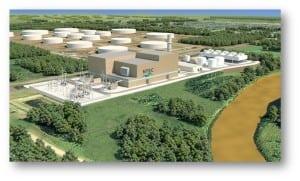Proposed Wisconsin Gas-Fired Plant Would Aid Utilities' Renewable Initiatives
Minnesota Power and Wisconsin’s Dairyland Power Cooperative announced plans to co-develop a combined cycle natural gas–fired power plant, a 550-MW facility designed to provide backup power for the utilities’ efforts to expand their use of renewable energy sources.
The Nemadji Trail Energy Center would be built along the Nemadji River in Superior, Wis., a location adjacent to both utilities’ service territories. The utilities would co-own the facility and divide its electrical power output. The companies said that if regulators approve the plan (a decision is expected sometime in 2018), construction could begin in 2020 and the $700-million plant—each company investing $350 million—could be operational in 2024 or 2025.
Minnesota Power spokeswoman Amy Rutledge said the Superior site’s access to existing natural gas and electric transmission lines made it a logical choice for the utilities. The area is served by multiple natural gas lines, including from Northern Natural Gas, Great Lakes Gas Transmission, and ANR Pipeline, according to analysts Rocco Canonica and Richard Frey of S&P Global and Platts Analytics.
City officials in Superior said the plant would be “one of the single largest private investments in the area’s history.” The plant is sited near the existing Calumet oil refinery, currently the city’s single largest employer and its largest industrial facility.
Combined cycle power plants produce electricity by mixing fuel with air, and capturing waste heat to increase efficiency and electrical output. A gas turbine compresses the incoming air, mixing it with fuel and heating it. The hot air-fuel mixture moves through the turbine, making the turbine’s blades spin.
The turbine drives a generator that converts some of the energy to electricity. A heat recovery system generator (HRSG) captures exhaust heat and creates steam, which is sent to a steam turbine that creates more electricity.

Barbara Nick, CEO and president of Dairyland Power, in a news release said “Natural gas plants provide critical backup to intermittent renewable sources of power, like solar and wind. The Nemadji Trail Energy Center will respond on demand, providing the energy required by our membership and Minnesota Power’s customers exactly when they need it, at the flip of a switch.” Nick, speaking at her company’s annual meeting in LaCrosse, Wis., on June 7, said the plant is part of Dairyland’s ongoing “Preferred Plan” for resource diversification.
Dairyland in 2016 announced 15 projects that would add more than 20 MW of solar power to the co-op’s system; several already are online in Wisconsin and Iowa, and all are expected to be in service in the next few weeks.
The Nemadji plant is one part of Minnesota Power’s EnergyForward initiative, designed to enhance the competitiveness and reliability of the company’s energy supply in its service territory in northeastern Minnesota. Minnesota Power, the utility division of Duluth, Minn.-based ALLETE Inc., also has asked state regulators for approval to add 250 MW of wind power capacity and 10 MW of solar power. The company already has 620 MW of wind power in its portfolio; the new solar power would double its solar generation.
“Through a unique partnership with Dairyland Power Cooperative and access to a competitive natural gas supply, this approximately $350-million investment will further balance Minnesota Power’s energy mix while contributing meaningful growth for ALLETE’s shareholders,” said Al Hodnik, the chairman, president and CEO of ALLETE. “Minnesota Power’s EnergyForward investments and industrial load prospects complement nicely the nexus of energy and water growth initiatives already announced and additional opportunities being pursued by ALLETE Clean Energy and U.S. Water.”
Minnesota Power in 2005 generated about 95% of its power from coal. The company since has mothballed or identified for removal about 700 MW of coal-fired generation on its system. The company has said its long-term goal is a portfolio of two-thirds renewable energy and natural gas, and one-third baseload coal.
“It’s really about giving customers affordable, reliable, less carbon-intensive energy,” said Julie Pierce, Minnesota Power’s vice president of strategy and planning, in an interview with the Duluth News Tribune. “What we’re doing with this is bringing in flexible generation … to back us up.”
Dairyland and Minnesota Power officials say the plant would be a “renewable-enabling” power source, providing electricity as a backup to wind and solar generation. “If everyone just built the green stuff, that’s when we could find ourselves with reliability that could be very precarious,” Pierce told the News Tribune.
She said the utility’s largest customers are taconite plants on the state’s Iron Range that operate 24 hours a day, seven days a week. “I can’t emphasize enough … the need for reliability and affordability.” The Iron Range in northern Minnesota is about 90 miles north of Superior, near Hibbing, Minn.
Approval of Minnesota Power’s proposed resource package by the Minnesota Public Utilities Commission (MPUC) would mean that renewable energy would account for 44% of the utility’s energy supply after Nemadji comes online.
At present, Minnesota Power operates 10 hydro plants, two biomass and coal plants, two wind farms, two coal plants, and one natural gas–fired plant. The company has already met or exceeded state standards for renewable power, along with energy conservation and carbon emissions, through a fleet transition of smaller coal units and its increasing use of wind and solar power.
Dairyland Power Cooperative distributes power from several facilities, including three landfill gas-to-energy (LGE) plants—two in Wisconsin and one in Iowa. It also has an animal waste-to-energy facility in Wisconsin and purchases power from wind farms in Iowa and Wisconsin.
—Darrell Proctor is a POWER associate editor.